Some people love the color purple and want their favorite color to translate into the landscaping around their home.
Well, those people are in luck! Nature has given us numerous purple flowering trees to create a show-stopping feature.
Wisteria

One of the most well-known purple flowering plants is the Wisteria. Some people believe that Wisteria are trees but are classified as vines. Wisteria can still grow almost as large as trees with the proper supports.
Wisteria reminds me of Weeping Willow trees because the vines hang down from whatever they are growing on with massive amounts of lilac-colored flowers.
As beautiful as Wisteria is, I recommend planting them on a sturdy pergola or archway away from your home. Wisteria acts more like ivy and will vigorously grow on anything it can attach to, including your house.
You might think it would be beautiful to have Wisteria growing on your house – and it might be – but Wisteria vines become heavy with age and can destroy the façade of your house, especially if you have siding on your house rather than bare brick.
Wisteria grows well on its own, but you will want to ensure that you prune it at the end of the growing season. Simply cut away almost half of the growth of the plant. Don’t worry – it will quickly grow back in the next growing season!
Crape Myrtle
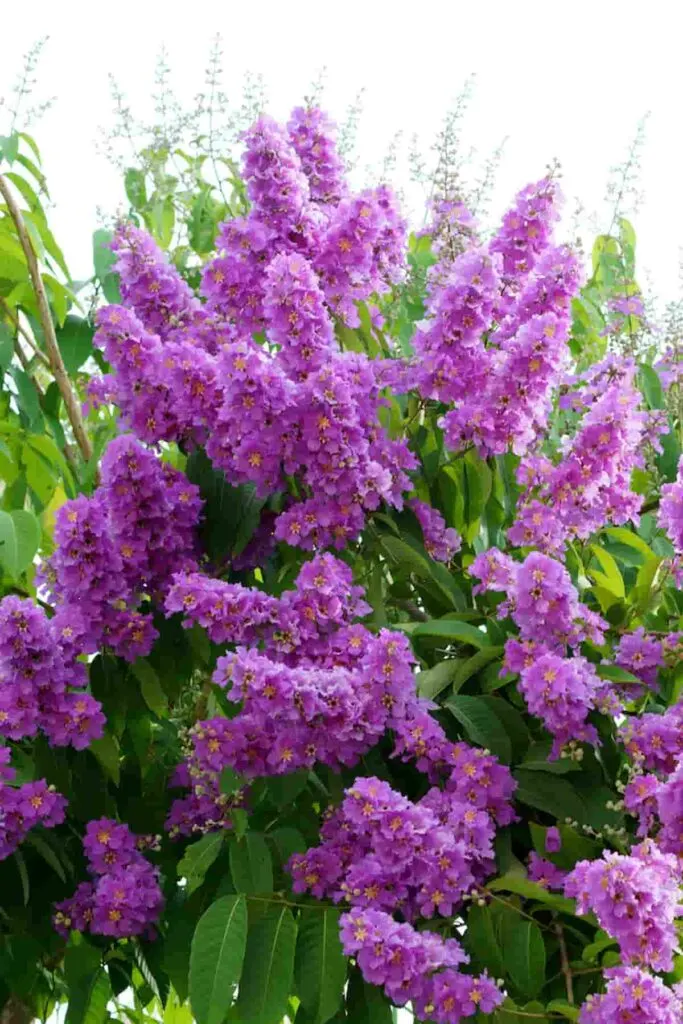
The Crape Myrtle is a small tree, but don’t let its small size fool you – it has amazingly dense flowers when it blooms!
The size of your Crape Myrtle will depend on the kind of variety that you have, which can range from less than 4 feet to over 20 feet! People who are looking for a smaller tree can purchase the Dwarf Crape Myrtle, but you can also buy a regular Crape Myrtle if you want to make sure you grow a tree to its fullest potential.
The Crape Myrtle can last anywhere from 50 to over 100 years in the right conditions. If you’ve ever been to the Southern United States, you’ve surely come across a Crape Myrtle tree over ten decades old.
You can grow a Crape Myrtle just about anywhere in the United States, but the best Crape Myrtles tend to be, as mentioned above, in the Southern United States, where there is more sun throughout the year.
As long as the Crape Myrtle has lots of sunlight and gets pruned in February, you’ll have a beautiful show of purple flowers in March or April each year.
Desert Willow
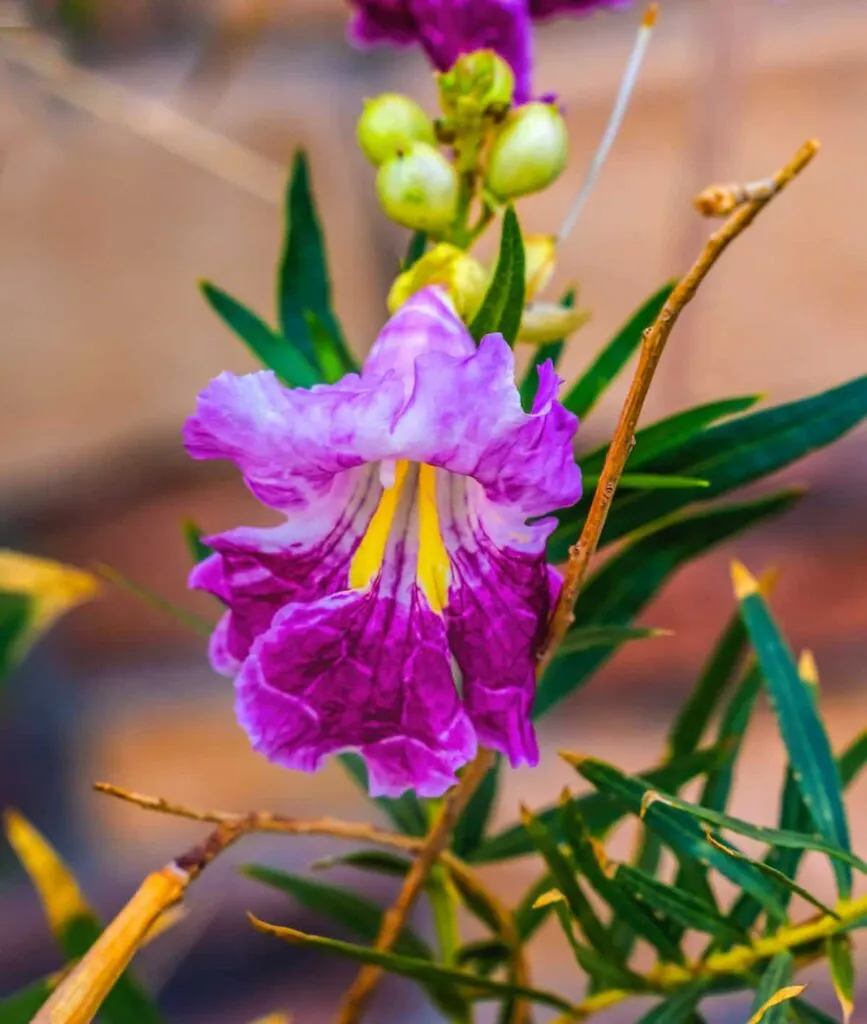
The Desert Willow is a properly named purple flowering tree that is found in the South of the United States in states like Texas, New Mexico, and Arizona – this tree likes the sunlight!
The Desert Willow has purple flowers that are an interesting shape with petals that look ruffled. From far away, you might even think that this is a tree of snapdragons.
Most flowers on the Desert Willow are dark pink or purple but have a little interest, with streaks of white or yellow up from the base of the flower petals.
Desert Willow trees are the perfect choice if you live in the arid Southern United States, where you are prone to droughts. You don’t need to worry about getting your Desert Willow enough water like your other plants.
The Desert Willow will thrive on little water and is drought tolerant, so it needs just enough water to keep it flowering. This tree doesn’t need to be on your list of worries when water is scarce, and it will keep your garden looking flourishing when other plants are dying!
Jacaranda
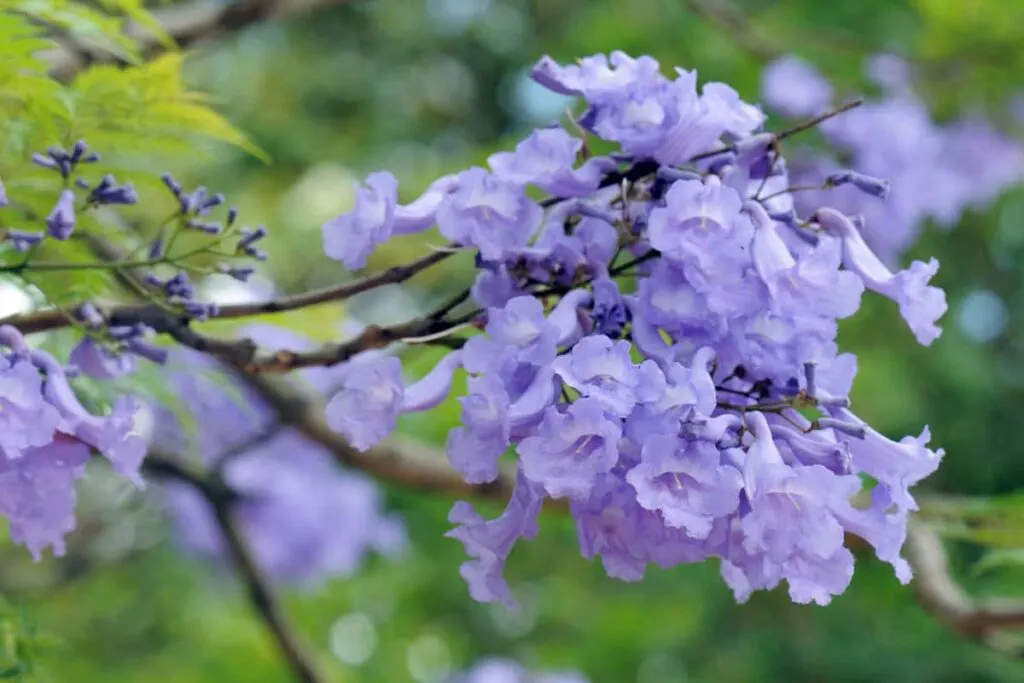
Have you heard of a Jacaranda tree? If not, you’re in for a treat if you’re on the hunt for a tree with purple flowers.
Jacaranda trees are native to the tropical climates in the United States, so, unfortunately, only the most southern states will be able to properly grow Jacaranda trees. The USDA notes that the tree grows best in zones 10 and 11. This may not mean much to you, but this includes places such as:
- Northern Texas
- Northern Mississippi
- Northern Alabama
- Eastern California
- Almost all of New Mexico
Since the Jacaranda is from a tropical climate, the tree likes its soil to be wet. Jacaranda trees should be watered for at least a half-hour to give the tree and its roots a deep soak. You might not be used to this, but it is important to do!
The tree itself can be a pain as beautiful as the canopy of bright purple flowers. Here are some of the cons of this tree:
- Deep, large roots that can break sidewalks or create uneven walkways
- Its flowers and foliage fall, causing slipping hazards or clogging pool filters
- General clean-up of flowers
- Tree needs yearly pruning and shaping for the full effect
- It can be grown inside, but it will not flower
Chaste Tree
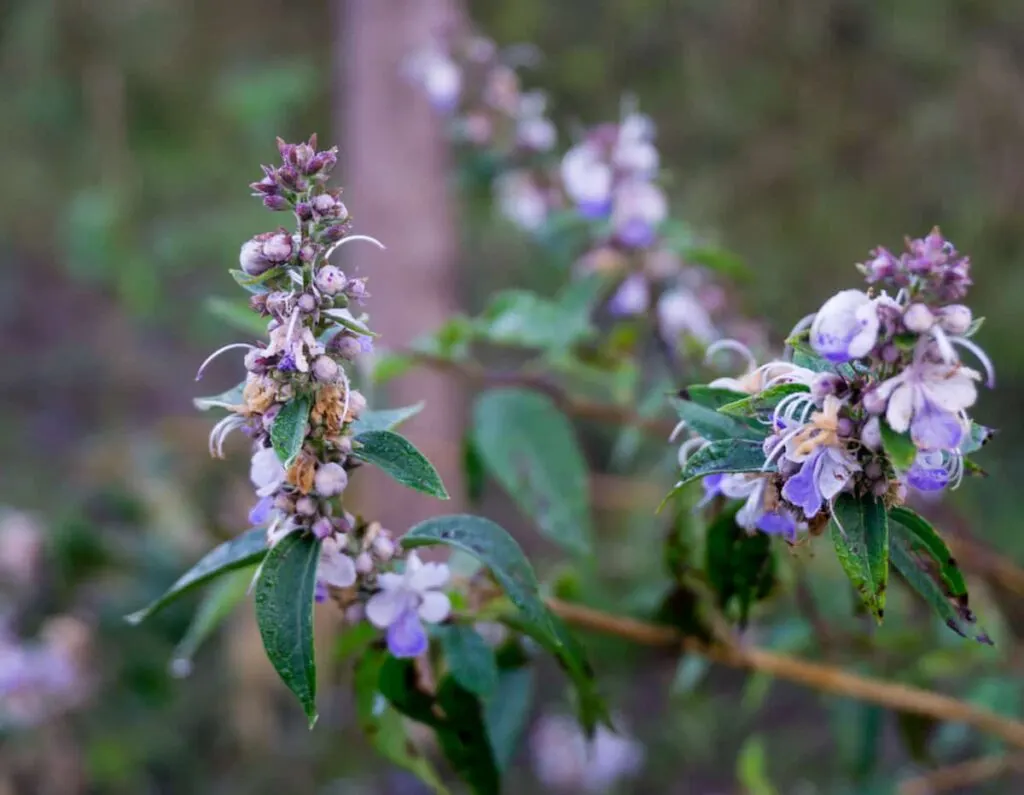
The Chaste tree is another variety of tree that is more common in the Southern United States. Northern Americans cannot be upset and jealous, though; Southerners use the Chaste tree to replace lilac bushes, which cannot grow well in the South.
To the untrained person, a Chaste tree may look like a lilac bush – and for a good reason. The purple flowers grow in cone shapes, just like a lilac bush.
Chaste trees can also be mistaken for lilac bushes because of their relatively small size. Most Chaste trees will only grow to 10 feet or a little higher if you properly care for your tree.
Chaste trees need full sun, but that’s not why they thrive in the South. It is more a matter of convenience. If a Chaste tree is hit with frost or cold temperatures, it will die down to the ground, but its roots are hardy and will regrow.
Do you – if you live in the Northern United States – want to deal with waiting for your Chaste tree to regrow every year? I know I don’t!
Eastern Redbud
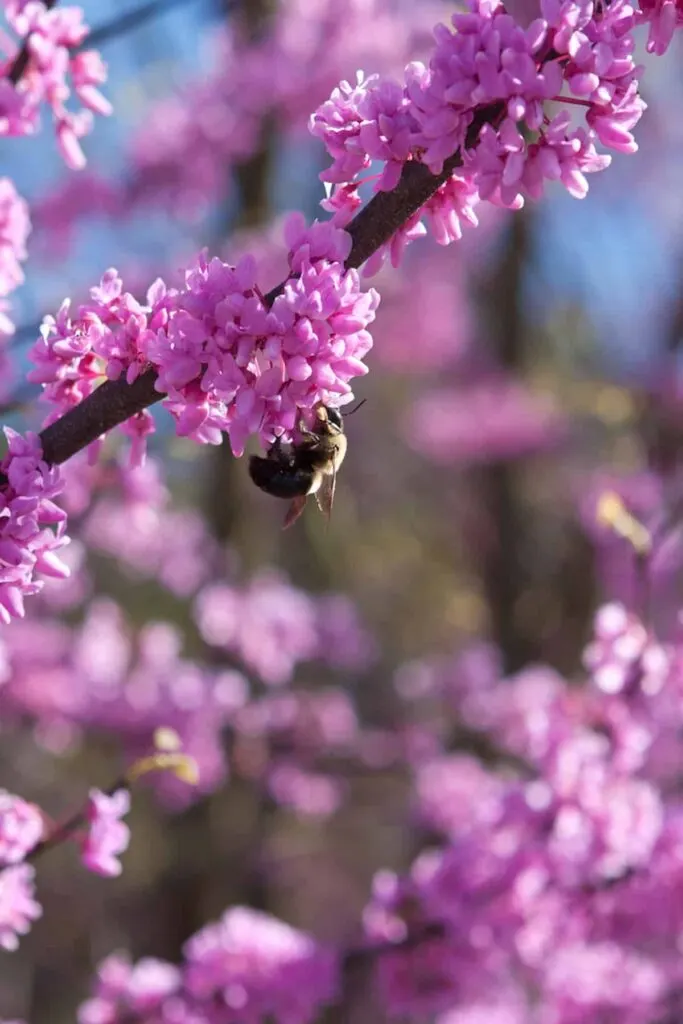
You might be thinking, wait, isn’t the Eastern Redbud tree red because it’s in the name? No, the Eastern Redbud is a purple flowering tree.
The flowers on the Eastern Redbud are a rosy pink, technically, but if you aren’t up close, the flowers certainly look more purple than pink. You’ll be able to tell me if I’m wrong or not when you see the flowers in April each year.
The Eastern Redbud is a great choice if you aren’t much of a gardener because the tree crowns by itself without much work on your own. For someone like me, that’s the perfect tree, so I don’t need to get on a ladder to trim my tree!
Several trees on this list are native to the Southern United States, but the Eastern Redbud tree spreads the love around most of the United States! The tree won’t grow in the country’s coldest or hottest parts, but otherwise, you can also be the proud owner of the Eastern Redbud.
Magnolia
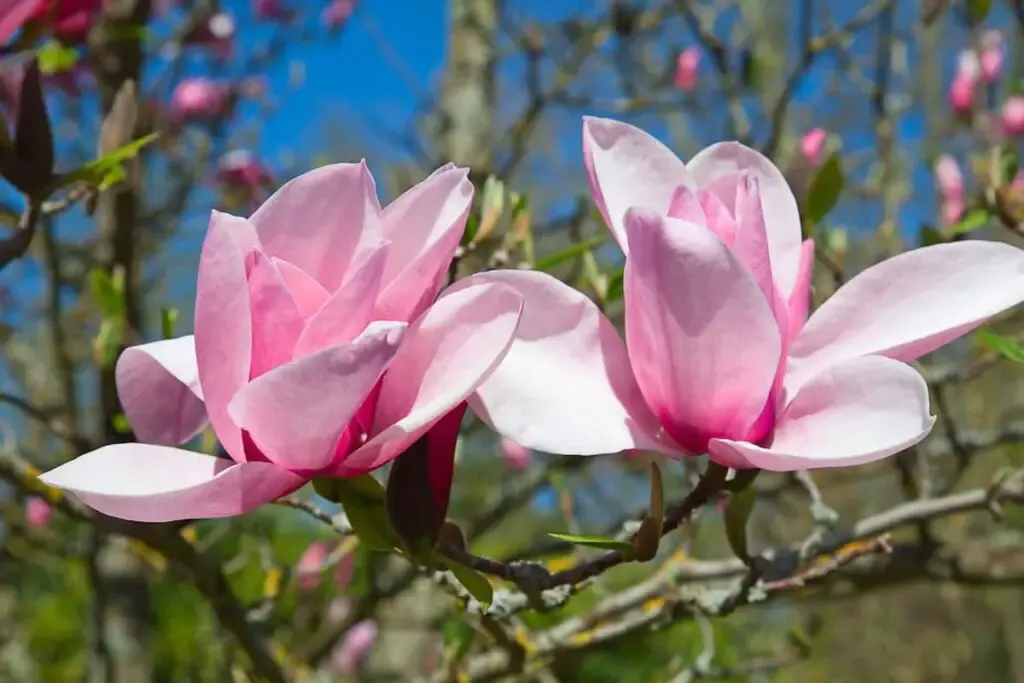
Magnolia trees have no shortage of colors, and of course, purple makes their list of colors too.
Aside from purple, you can also find Magnolia trees in the following colors:
- Pink
- White
- Blue
- Yellow
You might be excited by the options of Magnolia trees, but let’s focus on the purple flowering Magnolia trees.
Purple flowering Magnolia trees called, quite aptly, the Saucer Magnolia have wonderfully purple saucer-shaped petals that are sure to catch anyone’s eyes.
If you’re looking for a purple Magnolia tree that has a softer look, then the Lily Magnolia is what you should look for.
Whether you’re looking for a bold-shaped flower or something that has a gentler appearance, the Magnolia tree has something for you!

Hi there, my name is Allie and welcome to my blog; GareningWithAllie!
Much of what you see written here is just our personal experiences with gardening. Along with the content I write here, there is also a unique collection of gardening topics covered by some of our close friends. I hope you find everything you read here to be helpful, informative, and something that can make your gardening journey the most lovely experience ever! With that said, Happy Gardening!
